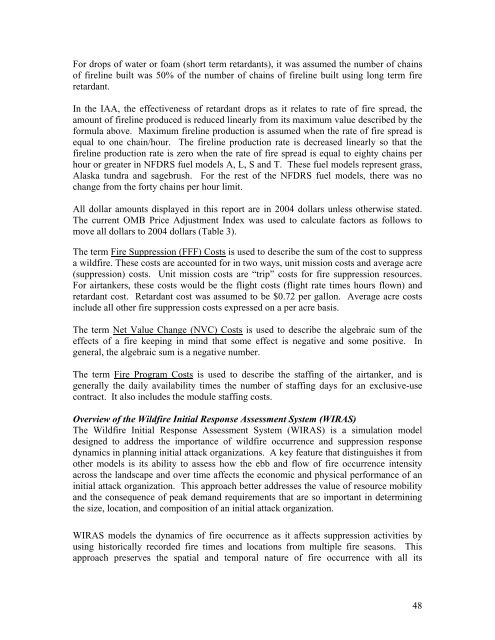Interagency Aviation Strategy - July 2008 - National Wildfire ...
Interagency Aviation Strategy - July 2008 - National Wildfire ...
Interagency Aviation Strategy - July 2008 - National Wildfire ...
Create successful ePaper yourself
Turn your PDF publications into a flip-book with our unique Google optimized e-Paper software.
For drops of water or foam (short term retardants), it was assumed the number of chains<br />
of fireline built was 50% of the number of chains of fireline built using long term fire<br />
retardant.<br />
In the IAA, the effectiveness of retardant drops as it relates to rate of fire spread, the<br />
amount of fireline produced is reduced linearly from its maximum value described by the<br />
formula above. Maximum fireline production is assumed when the rate of fire spread is<br />
equal to one chain/hour. The fireline production rate is decreased linearly so that the<br />
fireline production rate is zero when the rate of fire spread is equal to eighty chains per<br />
hour or greater in NFDRS fuel models A, L, S and T. These fuel models represent grass,<br />
Alaska tundra and sagebrush. For the rest of the NFDRS fuel models, there was no<br />
change from the forty chains per hour limit.<br />
All dollar amounts displayed in this report are in 2004 dollars unless otherwise stated.<br />
The current OMB Price Adjustment Index was used to calculate factors as follows to<br />
move all dollars to 2004 dollars (Table 3).<br />
The term Fire Suppression (FFF) Costs is used to describe the sum of the cost to suppress<br />
a wildfire. These costs are accounted for in two ways, unit mission costs and average acre<br />
(suppression) costs. Unit mission costs are “trip” costs for fire suppression resources.<br />
For airtankers, these costs would be the flight costs (flight rate times hours flown) and<br />
retardant cost. Retardant cost was assumed to be $0.72 per gallon. Average acre costs<br />
include all other fire suppression costs expressed on a per acre basis.<br />
The term Net Value Change (NVC) Costs is used to describe the algebraic sum of the<br />
effects of a fire keeping in mind that some effect is negative and some positive. In<br />
general, the algebraic sum is a negative number.<br />
The term Fire Program Costs is used to describe the staffing of the airtanker, and is<br />
generally the daily availability times the number of staffing days for an exclusive-use<br />
contract. It also includes the module staffing costs.<br />
Overview of the <strong>Wildfire</strong> Initial Response Assessment System (WIRAS)<br />
The <strong>Wildfire</strong> Initial Response Assessment System (WIRAS) is a simulation model<br />
designed to address the importance of wildfire occurrence and suppression response<br />
dynamics in planning initial attack organizations. A key feature that distinguishes it from<br />
other models is its ability to assess how the ebb and flow of fire occurrence intensity<br />
across the landscape and over time affects the economic and physical performance of an<br />
initial attack organization. This approach better addresses the value of resource mobility<br />
and the consequence of peak demand requirements that are so important in determining<br />
the size, location, and composition of an initial attack organization.<br />
WIRAS models the dynamics of fire occurrence as it affects suppression activities by<br />
using historically recorded fire times and locations from multiple fire seasons. This<br />
approach preserves the spatial and temporal nature of fire occurrence with all its<br />
48
















